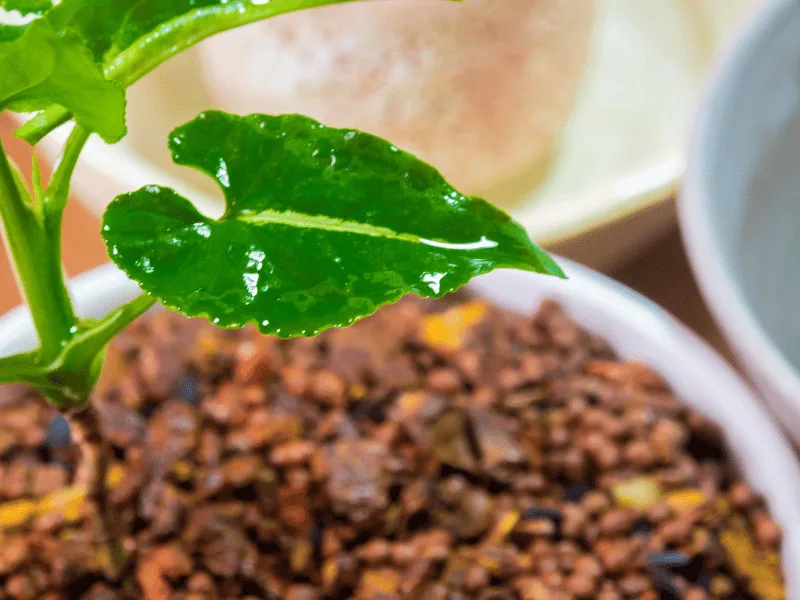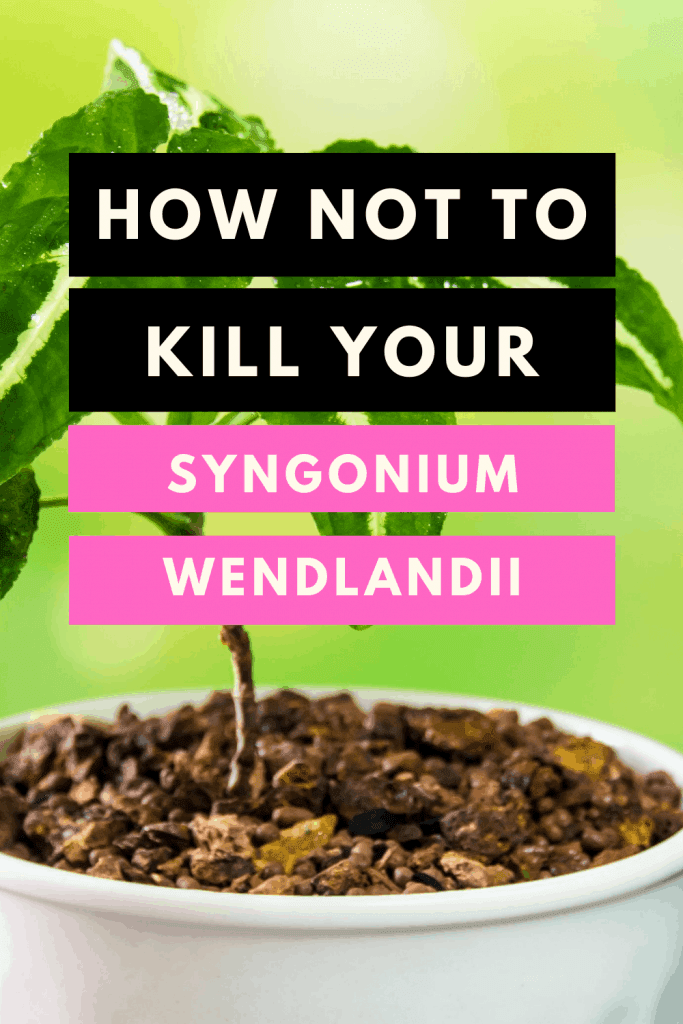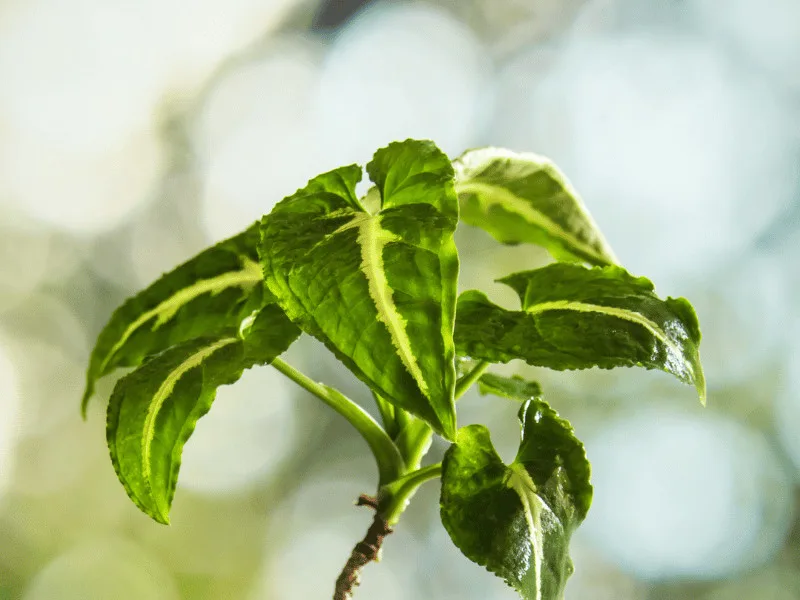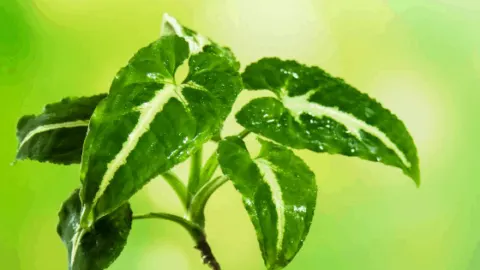You are reading this article because you are interested in Syngonium wendlandii care and want to know more about Wendland’s Arrowhead.
According to Chinese belief, plants decorate your house and transmit energy that affects your mental health.
Syngonium is considered a perfect Feng Shui plant. This is because it purifies the air, grows upwards (positive energy flow) and has arrow-shaped leaves that provide direction. The green leaves stand for wood. This signifies vitality and growth.

Syngonium wendlandii Takeaways
| Species | Syngonium wendlandii |
| Synonyms | Wendland's Arrowhead Vine,Goosefoot Plant |
| Family | Araceae |
| Genus | Syngonium |
| Growth | Climbing, Trailing |
| Height | 2 feet |
| Width | 1 feet |
| Soil | Well-draining and rich in organic matter |
| Watering | Every 7-10 days |
| Light | Bright Indirect |
| Temperature | 65-85 °F (18-30°C) |
| Humidity | 55-80% |
| Fertilizer | Fertilize every 14 days in spring and summer |
| Propagation | Stem cuttings, rootball division |
| Toxicity | Toxic to cats, dogs and humans. Contains water-insoluble calcium oxalate crystals |
Table of Contents
Syngonium wendlandii Plant
Syngonium wendlandii is native to the tropical regions of Central and South America. It is one of the two most famous Syngonium species; the other is Syngonium podophyllum.
It belongs to the Araceae plant family (Aroids) and is also known as the Silver Goosefoot plant because of the goose feet shaped juvenile leaves. This Arrowhead plant falls is a vining and climbing plant. It has variegated foliage in shades of green, white, and silver.
The Wendlandii purifies the air. It absorbs toxins from indoor spaces. It is an excellent choice for places with little or no air ventilation. It has a high rate of transpiration; that’s why it helps to increase the humidity within a room.
As a houseplant, you can grow it as a hanging plant letting the vines dangle from the pot or provide support to let it grow as a climber.
Syngonium wendlandii Care
Syngonium wendlandii is a slow-growing plant that is easy to grow and care for. It needs regular watering every 7-10 days, a well-draining mixture using peat, perlite, and sand. This plant thrives in bright indirect sunlight. Fertilize it using a balanced fertilizer every 2 weeks in spring and summer.

Syngonium wendlandii Care
What is the best Soil for Syngonium wendlandii?
Grow the Syngonium wendlandii in a free-draining peat mixture. The potting mixture needs excellent moisture retention properties.
The ideal soil pH range is between 6 -7.5. And the suitable outdoor USDA planting zones are 9b, 10a, 10b, and 11.
This plant has an aerial root system. So the container you are using should have good drainage options with at least one drainage hole.
You can prepare your own substrate by taking 4 parts peat per 1 part of sand. If you don’t have access to good quality sand, you can replace it with polyurethane or perlite.

How often do you Water a Syngonium wendlandii?
Water Syngonium wendlandii once a week to every ten days in the morning.
Keep the soil moist in the summer months, when watering saturate the soil until water starts draining from the bottom.
You have to allow the plant to dry out partially before the next watering; the best approach is to let the top few inches of soil dry. Reduce watering in winter months, but don’t let the plant dry out completely.
The Syngonium Wendlandii plant will not tolerate wet soil at all. At the same time, under-watering will cause the lower leaves to dry out and turn brown. To rehydrate the plant soak the soil in water.
Remember that the amount of light provided and the current season will control the frequencies of watering per week. The plants located in a dark area requires less water compared to the one in a bright location.
Clean the leaves once a week using water in a spray bottle. The leaves have small holes that can be clogged with dust particles.
This will make it difficult for the plant to breathe, and your plant will start dying. Do not let the foliage remain wet for a long time since this can lead to powdery mildew.
If you live in a dry climate, you may have to water this plant daily. Syngonium Wendlandii requires regular watering, but to protect from root rot, ensure that the soil does not remain standing in water.
How much Light does the Silver Goosefoot plant need?
Lighting needs for this plant are simple, bright filtered light with no direct sun. If you are using artificial lights, it should be at a height of 8-16 inches (20-40 cm) above the plant.
It can be grown in any shaded area outdoors that does not get much direct light. One hour of direct sunlight is fine for the outdoor plant’s growth.
Professional gardeners and plant nurseries say the Syngonium Wendlandii can tolerate both low and bright light.
But if you want your plant to grow faster and maintain its vibrant colored leaves, it’s best to keep in medium to bright light. In low-light conditions, the leaves may lose their variegation.
In subtropical regions, keep it in partial shade, and your plant will grow very well.
Avoid prolonged sun exposure in summer and spring; it will scorch the leaves damaging the beautiful foliage.
Similarly, keeping your plant in a dark location will reduce the variegations and increase the chances of mold growth on the soil. So choose a location with partial shade for optimum growth.
Syngonium wendlandii is one of the easiest indoor plants for beginners. I suggest experimenting and observing what the best position for your plant is.
What is the ideal Temperature for a Syngonium wendlandii?
The ideal day temperature is between 50 – 85 o F (15 – 30 degrees Celsius). The night temperature should be 53 – 65 oF (12-18 degrees Celsius).
This plant is not frost hardy, so don’t keep it in temperatures below 50 oF ( 10 degrees Celsius).
Syngonium Wendlandii plant cannot tolerate sudden temperature changes; therefore, try to maintain a constant temperature throughout the year.
What Humidity is best for Syngonium wendlandii?
A humidity level between 60-80% is optimal for Syngoniumn wendlandii.
If you notice any brown leaf tips with yellow halos, your plant definitely needs more humidity.
High humidity is preferable, but average household humidity ranging from 40-50% is also acceptable for this plant. You can use a pebble tray to maintain a good humidity level.
How often do I Fertilize a Syngonium wendlandii?
Use an organic NPK fertilizer for 2 to 3 months during the growing season. Dissolve 2-3 gm of fertilizer in 1-liter water and spray the mixture on the plant. Fertilize the plant with this mixture once a month.
Alternatively, you can feed the Syngonium Wendlandii every two weeks with a balanced house plant fertilizer diluted to half strength. In winter, reduce the fertilizing to once a month only.
Another option is a slow-release fertilizer or a top dressing with compost or worm castings in early spring. With slow-release fertilizer, use calcium compounds to increase the soil pH.
Avoid over-fertilizing as salt build-ups and chemicals can burn the roots, causing stunted growth and yellowing leaves with time.
Repotting a Goosefoot Plant
Repot Syngonium w endlandii every two years. Use shallow pots, as the roots don’t go very deep.
Goosefoot Plant does well in small pots. But if the plant is outgrowing its pot and roots come out of the drainage holes, repot in a bigger pot in spring. You can use any standard compost mix while repotting that is light and free draining.
One of the distinguishing factors about Wendlandii is its ability to creep and gradually take over the adjoining areas.
Pruning
Prune your Silver Goosefoot plant periodically if it gets shrubby. The fun part about this plant is that you can grow it as a compact, bushy plant, or admire its climbing nature and grow it tall on a moss stick. Pinch the stems to encourage new growth.
Using sterilized garden tools, remove the yellowed or dying leaves and plant debris to promote better growth. This will reduce the chances of bacterial or fungal diseases.
While pruning, do not remove its aerial roots or runners that develop along the stem, as it may result in stressing the plant.
Syngonium wendlandii Propagation
Propagation via stem cuttings or suckers is the best option for Syngonium wendlandii.
Good plant hygiene is a crucial element for successful propagation. The pruning shears or knife must be dirt-free and sterilized with rubbing alcohol.
If you don’t disinfect your tools, there is a high risk of infecting both the mother plant and the newly propagated plant. Water the soil 24 hours before you take any cuttings; this will reduce the risk of transplant shock.
Stem cuttings:
- For stem cuttings, choose a semi-wooded stem that can be bent slightly. Do not use diseased or weakened stems, as they may not root well. Before proceeding, remove the lower half of the leaves.
- Use an aerated soil mixture with a fluffy texture and perlite. 7cm pots are ideal for planting the new cutting, but ensure the pot has drainage holes. Place the cutting vertically in the middle 0.8 inches (2cm) deep in the soil layer.
- Place the pot in a transparent bag or box. This confined environment will increase humidity and reduce the rate of transpiration.
- Open the bag every few days for air circulation. Make sure the potting mixture is evenly moist and not soggy. You don’t have to water the plant very often. The humidity in the transparent bag will hydrate the leaves and stems.
- Position the container in a bright spot with indirect light away from any heat source and maintain a temperature of about 64o F (18 degrees Celsius) for root development.
- You can use a heating pad to speed up the process for a colder climate. In approximately eight weeks), the roots will develop. You can remove the bag once new leaves have started to grow.
Sucker cuttings:
- If you want to propagate via sucker cuttings, take a section around 4 inches (10cm), with a small root system It has already been attached.. If you don’t have any roots on the sucker sections, you can propagate them in water instead of planting them in soil.
- Water propagation has a higher success rate for Syngonium Wendlandii since it roots faster in water. You should replace the water every ten days and remove any dead leaves.
- Changing the water is also necessary to avoid any bacterial growth. Stale water can harbor bacteria leading to stem and root rot. Every other step for water propagation is similar to the ones mentioned previously.
- Once the roots are 3cm or longer, your new cutting can be planted in its permanent container. Place the young plant in a pot with a peat-based soil medium. Always use a fresh or well-stored batch of compost for planting.
- Follow the care steps discussed in this article to help the cutting grow into a sturdy plant.
Syngonium wendlandii Blooms
Syngonium wendlandii has tiny, creamy-white flowers with greenish hood-like spathe and bulbous base along the finger-like spadix. These tiny flowers appear in clusters near the bottom.
Blooming is rare for this particular plant when grown as an indoor houseplant. But some growers have had blooms in the spring season for the ones growing in outdoor gardens.
Syngonium Wendlandii blooms are typically observed in mature climbing plants; young plants don’t bloom at all.
Syngonium wendlandii Growth Rate
Syngonium Wendlandii plant has a slow growth rate, but a fully mature plant is 5 feet in height (152cm) and 2 feet in width (61 cm). The plant will reach its ultimate height in 5-10 years.
This plant will start as compact, but as it matures, it spreads in all directions. Provide the plant adequate support to climb on, and you can enjoy the long vines.
Wendlandii has dark green velvety leaves on long stalks, and the central vein is silvery. The silver variegation in the midrib of the leaves is the most distinctive feature that resembles a feather.
This climbing aroid has patterned leaves that change as the plant matures. When the plant is young, leaves are heart-shaped, and as it matures, the leaves become more arrow-shaped and have no white markings. Each leaf is unique, with a distinctive arrow shape.
Common Problem for Syngonium Wendlandii
Leaf spot: Fungal infections cause brown or yellow leaf spots. Use a low-nitrogen fertilizer and apply mancozeb to protect the plant from further damage.
To prevent any fungus growth on Syngonium Wendlandii, you should avoid excessive watering and high temperatures.
Bacterial rots: Many growers have experienced bacterial diseases in arrowhead plants. The infected plant has dark green spots on the leaves and an unpleasant odor. The lower leaves will start wilting and dying. Take out the Syngonium plant from the pot and examine the roots. If they are yellow and firm, the plant is good to go. But if any of them are brown and mushy, the roots are probably rotting.
Scale insect: This common houseplant pest is quite destructive. These insects feed on the sap and excrete a sugary liquid, which makes the foliage appear shiny and sticky. Another indication is brown bumps on the leaves. This not only damages the plant but makes it vulnerable to other diseases.
To kill scale insects, use isopropyl alcohol, dip cotton swabs in it and dab them on the scale insects. Then scrape off the dead scale insects from the plant.
Thrips: If the young plant has distorted and yellow leaves, it might be infected with thrips. Clean the plant in autumn to prevent overwintering of these pests.
Spray the plant with a copper fungicide and apply organic oil, such as neem oil.
Aphids: When the Syngonium Wendlandii plant is infested with aphids, new leaves are distorted and yellow. The foliage and stems are also covered in sooty mold.
Aphids are mostly found on the young leaves. Treat your plant with insecticidal soap followed by neem oil to get rid of aphids.
Spider mites: They are small chlorophyll sucking pests that can cause havoc if left untreated. Host areas for these pests are under-leaves, the cubby holes between the stem & petiole, and the area along the midrib.
Inspect these areas regularly while watering or cleaning the plant to spot any infestations. You can get rid of them with any horticulture or insecticidal spray/soap.
Mealybugs: If the new growth on the Syngonium Wendlandii appears distorted with a whitish substance in the leaf axils, the plant is probably infected with mealybugs. This houseplant can be treated with isopropyl alcohol or neem oil.
Overwatering, underwatering, and excessive direct sunlight all create issues for this climbing vine.
Overwatering encourages root rot, which may cause the plant to fail as the roots are unable to circulate moisture and nutrients above ground due to being waterlogged.
The lower leaves will start yellowing, brown, black, or yellow leaf blotches will appear, and the stems, roots will start rotting.
When under-watered Syngonium Wendlandii starts to dry out, causing the foliage to fade or turn brown.
Sunburns or scorching due to prolonged direct sunlight will also cause the plant to dry out. The variegated foliage will turn brown, and the plant health will decline.
It’s a good practice to examine the foliage and stems for pests and diseases while watering or misting your plant.
Tips for growing a Syngonium wendlandii
- Turn the pot regularly to allow the plant to grow evenly.
- Dry to avoid frequent drought periods due to the increased risk of yellowing leaves and weak growth.
- Repot the plant every two years in the spring season. Hydrate it thoroughly for 24 hours to reduce the damage to the roots due to transplant shock.
- Do not compact the soil while placing the cutting in soil. This will force the oxygen above the soil line, suffocating the roots.
- Always use lukewarm water for water propagation or watering to prevent the plant from being shocked.
- Dust particles clog the leave pores reducing the light-capturing efficiency of the plant. You can wipe or hose down the topsides of the leaves once a month to remove any accumulated dust.
Syngonium Varieties
Here is a list of common Syngonium species:
Syngonium wendlandii vs. rayii
The main differences between Syngonium wendlandii and Syngonium rayii are that the wendlandii has arrowhead-shaped leaves. The rayii has lance-shaped, elongated leaves. The leaves of the rayii are dark green with iridescent veins that look silvery-white or metallic.
The wendlandii also has dark green leaves without the iridescent, metallic shine. Syngonium wendlandii grows larger and less compact than the Syngonium rayii.
Syngonium wendlandii mature
A mature Syngonium wendlandii matures within 5-10 years. It can grow up to 5 feet in height (152cm) and 2 feet in width (61 cm).
Frequently Asked Questions
Is Syngonium wendlandii poisonous?
It is a non-edible plant, and the vines are poisonous if swallowed. Place your plant at a high location away from pets and children.
My Syngonium wendlandii has lost most of its leaf variegation?
This is due to low-light conditions. Syngonium plants can be grown in semi-dark areas, but your plant will start losing its variegated look. Simply move the Wendlandii plant to a brighter location to allow the variegation to redevelop on new growth.
What plants are good companions for Syngonium wendlandii?
Red Aglaonema, pothos and philodendrons can be grown or grouped with Syngonium since the care for these is similar. The foliage and growth pattern for these three complements the Wendlandii plant.
Why is my Syngonium plant drooping?
For arrowhead plants, the most common reason for drooping is lack of water and dry soil condition. If the soil deeper than an inch or two is dry, your plant needs more water. Never let the Syngonium Wendlandii plant dry out completely.
What is the ideal plant location for Syngonium wendlandii?
Place this plant on living room tables, shaded balconies, or windowsills.
Is Syngonium wendlandii a rare plant?
It is not considered a rare plant. But it might be difficult to get as few plant shops sell this Syngonium.
Conclusion
This Feng Shui plant will bring beauty and luck to your home. Similar to other Syngonium plants, this species is easy to grow and tolerates low light levels.
But you have to pay attention to watering because that’s the main thing this plant needs to survive.
The lush green variegated foliage is the selling point for Syngonium plants since the blooms are rare and not very exciting.
The leaves for this species are velvety green with off-white to silver feathery variegation in the center and along the major veins.
Regular watering and a spritz on the lush green foliage will keep your Syngonium wendlandii plant happy and growing. This air-purifying plant absorbs toxins via its leaves. The toxins are then transferred to the root zone and utilized as plant nutrients.
Read about the Syngonium podophyllum next.

Daniel has been a plant enthusiast for over 20 years. He owns hundreds of houseplants and prepares for the chili growing seasons yearly with great anticipation. His favorite plants are plant species in the Araceae family, such as Monstera, Philodendron, and Anthurium. He also loves gardening and is growing hot peppers, tomatoes, and many more vegetables.


